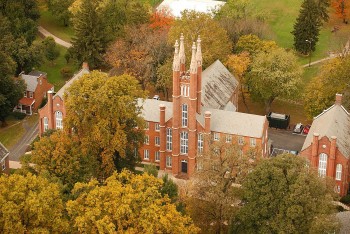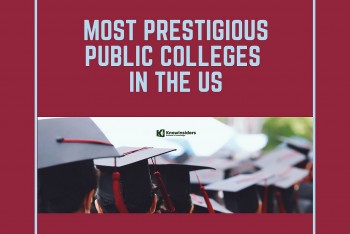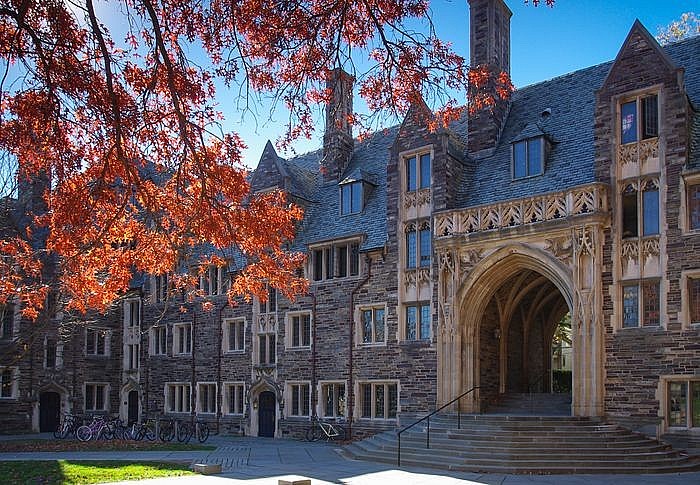Top 20 Most Prestigious Colleges In The U.S Today
 Top 15+ Most Expensive Colleges In The U.S (Updated) Top 15+ Most Expensive Colleges In The U.S (Updated) |
 Top 20 Most Prestigious Public Colleges In The US Top 20 Most Prestigious Public Colleges In The US |
 |
| Top 20 Most Prestigious Colleges In The US Today |
| Table of Contents |
We examined dozens of data points, including graduation rates, cost of attendance, financial aid, and alumni salaries, to identify colleges that combine quality and affordability. Here is a list of the top 20 most prestigious colleges where your tuition (and time) will most likely pay off.
Top 20 Most Prestigious Colleges In The US Today
1. Princeton University
Website: http://princeton.edu/
Annual Tuition: $82,300
Graduation rate: 98%
Acceptance rate: 4%
GPA: 3.93
Median SAT/ACT score: 1520/34
Undergraduate enrollment: 5,240
Everyone knows Princeton University is prestigious, but did you know it's also reasonably priced for those who get in? The school provides such large grants to the 6 in 10 qualifying families (households earning less than $250,000 generally receive some aid; those earning less than $100,000 receive a free ride) that more than 80% of students graduate debt-free.
On top of that, undergrads have access to some of the country's most well-known intellectual figures, including Angus Deaton, who won the Nobel Prize in economics in 2015, and novelist-turned-professor Joyce Carol Oates.
READ MORE: Top 10+ Most Prestigious Schools for Cognitive Science in The US Today
2. Havard University
Website: http://harvard.edu/
Annual tuition: $81,800
Graduation rate: 97%
Average time to a degree: 4.1 years
Acceptance rate: 4%
GPA: 4
Median SAT/ACT score: 1530/35
Undergraduate enrollment: 7,940
Harvard is probably the most closely associated with the Ivy League, and its illustrious reputation is well-deserved. Students have access to the world's largest university library as well as some of the world's most distinguished faculty members, including Nobel Prize-winning economist Alvin Roth and cognitive psychologist Steven Pinker. Harvard alumni dominate most professions, from music (cellist Yo-Yo Ma) to politics (former President Barack Obama) to law (Supreme Court Chief Justice John Roberts).
3. Kenyon College
Website: Kenyan.edu
Annual tuition: $84,100
Graduation rate: 97%
Acceptance rate: 37%
Median SAT/ACT score: 1420/33
Undergraduate enrollment: 1,870
Kenyon College, unlike many of the other top-rated liberal arts colleges on Money's list, is located far from the East Coast. In 1824, the rural Ohio college was established to train Episcopal clergy. Kenyon has become more competitive over time, and the college now routinely welcomes a freshman class whose students score in the top quadrant of SAT and ACT test-takers.
More than 30 majors and concentrations are available to the approximately 1,800 undergraduates. The 610-acre nature preserve, which includes forest, prairie, and wetland habitats, covers half of the 1,000-acre campus and allows students to hike the 14-mile trail network or conduct hands-on research.
READ MORE: Top 15 Best Online Colleges For Religious Studies In The US
4. Yale University
Annual tuition: $86,100
Website: http://yale.edu
Graduation rate: 97%
Acceptance rate: 5%
Median SAT/ACT score: 1530/34
Undergraduate enrollment: 6,540
Yale, like many of the other elite schools on the list, provides students with the opportunity to learn from some extraordinary minds, including Nobel Laureate economist William Nordhaus and Pulitzer Prize-winning poet Louise Gluck.
It comes as no surprise that Yale is one of the most selective universities in the country. It is, however, one of the most generous: Yale guarantees to "meet the full demonstrated financial need" of students. As a result, more than 80% of recent graduates graduate debt-free.
5. University of Notre Dame
Website: http://nd.edu
Annual tuition: $82,100
Graduation rate: 96%
Acceptance rate: 15%
Median SAT/ACT score: 1480/34
Undergraduate enrollment: 8,950
Although Notre Dame is a Catholic school that requires students to take at least two theology courses, students of all faiths are welcome. With a 15% acceptance rate, it is one of Money's most selective colleges. Although the university is best known for its humanities and business programs, it also excels in the sciences. According to the school, 84% of its pre-med graduates are accepted to medical school, which is twice the national average.
Notre Dame has one of the highest graduation rates in Money's rankings, with approximately 96% of students completing their studies within six years. Students fare very well on the job market, with early-career salaries about $93,000 in the decade after enrolling.
6. University of Pennsylvania
Website: http://upenn.edu/
Annual tuition: $87,300
Graduation rate: 96%
Acceptance rate: 6%
Median SAT/ACT score: 1530/34
Undergraduate enrollment: 10,640
Despite having one of the largest freshman classes in the Ivy League (around 2,400 students), admission to the University of Pennsylvania is extremely difficult. It had a 6% acceptance rate for the class of 2025.
However, once admitted, Penn students clearly thrive: 96% of students graduate within 6 years, making Penn one of the top graduation rates in Money's rankings. Business and economics, two of Penn's most prestigious departments, are notoriously demanding. In the name of stress relief, students in introductory economics hold a midnight "Econ scream" just before midterms, where they gather and scream in front of the test.
7. Amherst College
Website: http://amherst.edu/
Annual tuition: $83,900
Graduation rate: 95%
Acceptance rate: 9%
Median SAT/ACT score: 1460/33
Undergraduate enrollment: 1,970
Amherst, a historically top-ranked liberal arts college, has many characteristics that set it apart from other small elite colleges. Unlike most top schools, which require lowerclassmen to take a variety of basic core classes, Amherst has no required courses other than a first-year seminar emphasizing writing and critical thinking. Students can cross-register for courses at nearby schools University of Massachusetts, Hampshire, Mount Holyoke, and Smith for no additional cost thanks to a consortium.
With a student-faculty ratio of 7:1, the college is known for its dedication to teaching and close interaction between professors and students. Amherst is one of only a few schools that promises to meet 100% of a student's demonstrated financial need. The end result? Scholarships are typically awarded to students whose family income is less than $141,000.
8. Bowdoin College
Website: http://bowdoin.edu
Annual tuition: $80,000
Graduation rate: 95%
Acceptance rate: 9%
Median SAT/ACT score: 1420/33
Undergraduate enrollment: 1,950
Bowdoin College, an elite liberal arts college on the coast of Maine, has alumni including Netflix founder Reed Hastings and poet Henry Wadsworth Longfellow. Bowdoin has been test-optional long before it was fashionable: for more than 50 years, students have not been required to submit SAT or ACT scores.
Nonetheless, the college is extremely selective, accepting only about 9% of applicants. As part of the school's traditional liberal arts approach, its 2,000-plus students are required to take courses in all major disciplines, including math, science, the arts, and social sciences. Students can choose from over 40 majors and 45 minors, with government and legal studies, economics, and biology being the most popular.
9. Brown University
Website: http://brown.edu/
Annual tuition: $86,500
Graduation rate: 95%
Acceptance rate: 6%
Median SAT/ACT score: 1520/34
Undergraduate enrollment: 7,130
This Ivy League school has a 95% graduation rate and provides students with unusual academic freedom — the only course requirement is that they take at least two writing classes. Otherwise, undergrads can take whatever courses they want at Brown or the Rhode Island School of Design, which is just down College Hill. Grades are also optional — any class can be taken for satisfactory/no credit, which equates to pass/fail. Furthermore, students can create their own concentrations (what other colleges refer to as a major).
10. Cornell University
Website: http://cornell.edu/
Annual tuition: $84,100
Graduation rate: 95%
Acceptance rate: 9%
Median SAT/ACT score: 1510/34
Undergraduate enrollment: 15,450
Cornell is an unusual public-private hybrid that holds a unique position in the Ivy League. Residents of New York state can enroll in certain Cornell colleges and pay about $20,000 less per year than the rest of the university.
Cornell is known for being the largest and least selective of the Ivies, admitting about 9% of applicants into its 15,500-person undergraduate population. Cornell's private side includes a highly regarded College of Arts and Sciences, as well as architecture and hotel administration programs that are regarded as leaders in their fields. Recent graduates are more likely to find high-paying jobs, with the median salary being around $98,300 ten years after enrolling.
11. Georgetown University
Website: http://georgetown.edu/
Annual tuition: $85,400
Graduation rate: 95%
Acceptance rate: 12%
Median SAT/ACT score: 1480/34
SAT/ACT required? Yes
Undergraduate enrollment: 7,400
Georgetown, the country's oldest Jesuit university, is one of the more expensive schools in Money's rankings. However, one of the reasons for this is that its location in Washington, D.C. is one of its most appealing features, particularly for students interested in politics or international relations.
Georgetown, with its beautiful red brick campus overlooking the Potomac, frequently hosts Washington's elite to lecture or teach. Former House Speaker Nancy Pelosi, former Attorney General Eric Holder, and former President Bill Clinton all graduated from Georgetown. Among the other notable alumni are actor Bradley Cooper, comedian John Mulaney, and Today show host Savannah Guthrie.
12. Massachusetts Institute of Technology
Website: http://mit.edu/
Annual tuition: $80,700
Graduation rate: 95%
Acceptance rate: 4%
Median SAT/ACT score: 1540/35
SAT/ACT required? Yes
Undergraduate enrollment: 4,630
For good reason, MIT is one of the world's most prestigious science schools.
For starters, the selection process is notoriously competitive — only about 4% of applicants are accepted. Then there's the arduous workload, which includes required courses in physics, biology, chemistry, and calculus. Of course, MIT's professors are world-class, with ten Nobel laureates on the faculty.
Learning from the best is beneficial: The majority of the 95% of Techies who graduate within six years do well. The median salary a decade after graduation exceeds $124,000, making it one of the highest of any of the schools Money examined. While MIT isn't cheap, all students receive some sort of grant or scholarship to help them pay.
13. University of Chicago
Website: http://uchicago.edu/
Annual tuition: $88,200
Graduation rate: 95%
Acceptance rate: 6%
Median SAT/ACT score: 1550/34
Undergraduate enrollment: 7,560
While the official motto of the University of Chicago is "crescat scientia; vita excolatur," which translates to "let knowledge grow from more to more; and thus be human life enriched," some students refer to the school as "where fun goes to die."
That may be an exaggeration, but it captures the essence of UChicago's academic intensity. The school is extremely selective, with an acceptance rate of less than 6%. All 7,600 or so undergraduates are required to complete a rigorous liberal arts core curriculum, where A's are much more difficult to come by than at other schools. Even the academic calendar year, which is divided into quarters rather than semesters, tends to exacerbate the atmosphere on campus.
14. Williams College
Website: http://williams.edu
Annual tuition: $81,800
Graduation rate: 95%
Acceptance rate: 9%
Median SAT/ACT score: 1510/34
Undergraduate enrollment: 2,130
Williams College is one of the highest-rated liberal arts colleges in Money's rankings, thanks to a combination of high-quality academics and impressive career outcomes. Among its distinguishing features are plenty of personalized attention (the student-faculty ratio is a low 7:1) and an innovative tutorial system, modeled after one at Oxford University, that pairs two students who critique each other's papers and meet with their professor once a week. The system appears to be working: 96% of students graduate, and recent graduates earn an average of $74,500 per year.
15. Boston College
Website: http://bc.edu/
Annual tuition: $84,500
Graduation rate: 94%
Acceptance rate: 19%
Median SAT/ACT score: 1480/34
Undergraduate enrollment: 9,800
Undergraduates must complete a comprehensive core curriculum that includes subjects ranging from science to theology. Economics, finance, political science, and biology are popular majors. Boston College excels in terms of outcomes: It has a high six-year graduation rate of 94% (though this is slightly lower than expected given the student population).
16. California Institute of Technology
Website: http://caltech.edu/
Annual tuition: $83,800
Graduation rate: 94%
Acceptance rate: 4%
Undergraduate enrollment: 990
There are approximately 2,400 students on campus, but only about half are undergraduates. Ditch Day, a 100-year-old tradition in which seniors challenge undergraduates to "stacks" or puzzle-themed adventures, is one of the campus's most popular events. The residential houses, whose members are known by nicknames such as Moles, Pageboys, and Averites, are the focal point of most campus social life and traditions.
17. Dartmouth College
Website: http://dartmouth.edu/
Annual tuition: $85,400
Graduation rate: 94%
Acceptance rate: 6%
Median SAT/ACT score: 1500/34
Undergraduate enrollment: 4,530
Known as the smallest school in the Ivy League, Dartmouth places a special emphasis on undergraduate pedagogy. You won't see teaching assistants leading much classroom instruction, as they do at many large schools.
Dartmouth operates on an unusual, year-round quarter system (or D-plan) that gives students the flexibility to arrange, say, a winter internship and still graduate on time. According to Money’s calculations, Dartmouth has a 94% six-year graduation rate, and students go on to earn median salaries of about $95,500 in the first several years after college.
18. Duke University
Website: duke.edu
Annual tuition: $83,700
Graduation rate: 94%
Acceptance rate: 6%
Median SAT/ACT score: 1510/34
SAT/ACT required? Yes
Undergraduate enrollment: 6,820
Despite being a major research university, Duke provides its nearly 7,000 undergraduates with an unusual amount of direct interaction with professors. The student-faculty ratio is one of the lowest in Money's rankings, at 6:1, and more than half of students work on research projects with faculty members. Computer science, economics, and public policy are among the most popular majors.
Many professors are at the pinnacle of their fields, including Nobel laureate chemist Robert Lefkowitz, African and African American Studies chair Mark Anthony Neal, and scientists who spent years developing an invisibility cloak. (To be fair, scientists at Rochester and Central Florida universities have also contributed to the advancement of the science behind invisibility cloaks.)
19. Northwestern University
Website: http://northwestern.edu/
Annual tuition: $87,900
Graduation rate: 94%
Acceptance rate: 7%
Median SAT/ACT score: 1520/35
Undergraduate enrollment: 8,690
Anyone who visits Northwestern University will be impressed by its excellent academics and stunning location on the shores of Lake Michigan. The Evanston, Illinois, campus is divided into two sections: the creative arts and journalism students on the south end and the engineering and pre-professional schools on the north. While Northwestern has the resources and size of a Big Ten university, it also fosters a sense of community among its diverse student body of approximately 9,000 undergraduates and 14,500 graduate and professional students.
20. Stanford University
Website: http://stanford.edu/
Annual tuition: $82,700
Graduation rate: 94%
Acceptance rate: 4%
GPA: 3.96
Median SAT/ACT score: 1520/35
Undergraduate enrollment: 7,650
Stanford is one of the most difficult schools in the country to get into, with only 4% of applicants accepted. Once there, the educational requirements can be rigorous. Students frequently refer to themselves as "ducks," because they try to appear calm while desperately paddling to stay afloat. (There's even a Facebook group called "Stanford University Places I've Cried," which is a sarcastic "tribute to the happiest place on Earth.")
Conclusion
The university or college you attend can have a significant impact on the rest of your life, so it's probably a good idea to do some preliminary research. To help with the process, we've compiled a ranking of Top 20 Most Prestigious Colleges In The US Today. We hope the list is useful to you!
 Top 20 Most Prestigious Colleges for Marine Biology in the US 2023/2024 Top 20 Most Prestigious Colleges for Marine Biology in the US 2023/2024 More students are looking for the best colleges in marine biology, and here are the top 20 best schools in the United States to consider ... |
 Top 10+ Most Prestigious Online Courses for CyberSecurity Today Top 10+ Most Prestigious Online Courses for CyberSecurity Today The best cyber security courses available online simplify and streamline the process of acquiring and expanding one's knowledge of computer science and cybersecurity. |
 Top 15+ Most Prestigious Schools for Police Majors in the US Top 15+ Most Prestigious Schools for Police Majors in the US Maintaining law and order, apprehending thieves and criminals, and solving crimes on a local and high-quality level are all jobs that require graduates of police ... |
























